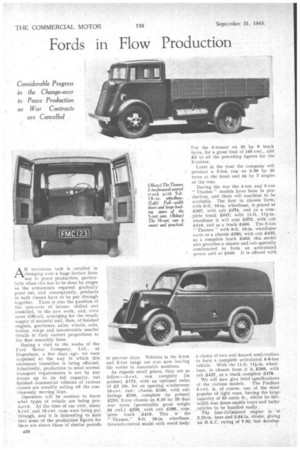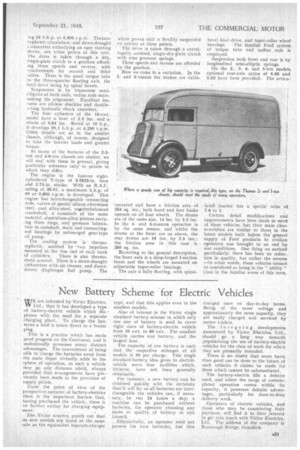Fords in Flow Production
Page 22

Page 23

If you've noticed an error in this article please click here to report it so we can fix it.
Considerable Progress in the Change-over to Peace Production as War Contracts are Cancelled
AN enormous task is entailed in changing over a huge factory from war to peace production, particularly when.this has to be done by stages as the armaments required gradually peter out, and consequently, products in both classes' have to be put through together. There is also the question of the turn-over of labour, skilled and unskilled, to the new work, and, even more difficult, arranging for the steady supply of material and, then, of finished engines, gearboxes, axles, wheels, cabs, bodies, wings and innumerable smaller details in their correct proportions to the flow assembly lines.
During a visit to the works of the Ford Motor . Company, Ltd., at Dagenham, a few days ago, we were surprised at the way in which this enormous transition is being effected. Admittedly, production to meet normal transport requirements is not by any means up to its full capacity-, but finished commercial vehicles of various classes are steadily rolling off the continuously moving lines.
Operators will be anxious to know what types of vehicle are being produced. At the time of onr visit, many 5-cwt. and 10-cwt. vans were being put through, and it is interesting to note that some of the production figures for these are above those of similar periods
in pre-war days. Vehicles in the 2-ton and 3-ton range are also now leaving the works in reasonable numbers.
As regards retail prices, they are as follow:-5-cwt. van complete (in primer) £175, with an optional extra of £2 105. for an opening windscreen; 10-cwt. van: chassis £180, with cab fittings £205, complete (in primer) £235; 2-ton chassis on 6.50 by 20 dual rear tyres (permissible gross weight 84 cwt.) £339, with cab £386, com plete truck ' £419. This is the " Thames," 9-ft. 10-in, wheelbase, forward-control model with wood body.
For the 3-tonner on 32 by 6 truck tyres, for a gross load of .105 cwt., add £5 to all the preceding figures for the 2-tonner.
Later in the yea:r the company will produce a 2-ton van on G.50 by 20 tyres at the front and 34 by 7 singles at the rear.
During the war the 4-ton and 5-ton " Thadies " models have been in production, and these will continue to be available. The first in Chassis 'form, with 9-ft. 10-in, wheelbase, is priced at £367, with cab LA& and as a cOrnplete truck £447; with 11-ft. 111-in, wheelbase it will cost £372, with cab £419, and as a truck £460. The 5-ton " Thames " with 9-ft. 10-in, wheelbase costs as a chassis £385, with cab £432, as a complete truck £465; this model also provides a chassis and cab specially constructed to form an articulated power unit at £440. It is offered with a choice of two well-known semi-trailers to form a complete articulated 6-8-ton vehicle. With the 11-ft. 111-in. wheelbase, in chassis form it is £390, with cab £437, as a truck complete £478.
We will now give brief specifications of the various models. The Fordson 5-cwt. is, of course, one of the most popular of light vans, having the large capacity of 65 cubic ft., whilst its fullwidth rear doors enable trays and bulky articles to be handled easily.
The four-cylindered engine is. 'of 2.23-in, bore and 3:64-in. stroke, giving att R.A.C. rating of 7.96, 'but develop ing 24 ti.h.p. at 4,400 r.p.m. Thermosyphonic circulation, and down-clraught carburetter embodying an easy starting device, are other points of this unit. The drive is taken through .a dry, single-plate clutch to a gearbox affording three speeds and reverse, with -ynchromesh for second and third ratios. There is the usual torque tube to the three-quarter floating axle, the final drive being by spiral bevels. .
Suspension is by transverse semirlliptics at both ends, radius rods main. taining the alignment. Excellent features are oil-less shackles and double.1cting hydraulic shock absorbers.
The four cylinders of the 10-cwt. model have a bore of 2,5 ins, and a stroke of 3.64 ins. Rated at 10 h,p., it develops 30.1 b.h.p. it 4,200 r.p.m. Other details are as in the smaller chassis, although, of course, designed to take the heavier loads and greater torque. .
As many of the features of the 2-3ton and 4-6-ton chassis are similar, we will deal with them in general, giving particular reference only to •points in which they differ. "
The engine -is the famous eightcylindered V-type of 3.0625=in. bore and 3.75-in. stroke. With an R.A.C. sating of 30.01, a maximum b.h.p. of SS at 3,800 r.p.m. is developed. This engine has interchangeable connecting rods, valves of special silicon chromium steel, cast alloy-steel, counterbalanced crankshaft, a camshaft of the same material, aluminium-alloy pistons carrying three rings, and pressure lubrication to camshaft, main and connectingrod bearings by submerged gear-type eil pump. • The . cooling system is thermosyphonic, assisted by two impellers mounted at the free end of each bank of cylinders." There is also therniostatic control. There is a down-draught carburetter with air cleaner, and directdriven diaphragm fuel pump. The whole power unit is flexibly suspended on rubber at three points.
• The drive is taken through a centrifugally .assisted, "single-dry-plate clutch with nine pressure springs.
Three speeds and reverse are afforded by the gearbox.
Now we come to a variation. In the 2and 3-tonner the brakes are cable
'operated and 'have a friction area of 264 sq. ins.; both hand and foot brake operate on all four wheels. The drums are of the same size, 14 ins. by 2.5 ins. In the 4and 5-tonners operation is by the same means, and whilst the drums at the front are as above, the rear drums are 16 ins. by 2.5 ins.; the friction area in this case is 289 sq. ins.
Reverting to the general description, the front axle is a drop-forged 1-section beam and the wheels are mounted on adjustable -taper-roller bearings.
The axle is fully floating, with spiral
bevel final drive, and taper-roller wheel bearings. The familiar Ford system of torque tube and radius rods is employed.
Suspension both front and rear is by longitudinal semi-elliptic springs.
On the 2-, 34and 5-ton models, optional rear-axle ratios of 6.66 and 5.83 have been provided.The articu latea." tractor has a special ratio of.
7.6 to 1. •
Certain detail modifications and improvements have been made in most of these vehicles, but their main characteristics are similar to those in the latest models built before the general supply of Ford products to civilian operators was brought to an end by war conditions. One thing we noticed particularly: there has been no reduction in quality, but rather the reverse —in other words, these vehicles cannot be considered as being in the " utility " class in the familiar sense of this term.




















































